Discovering Franciacorta
14th May 2024
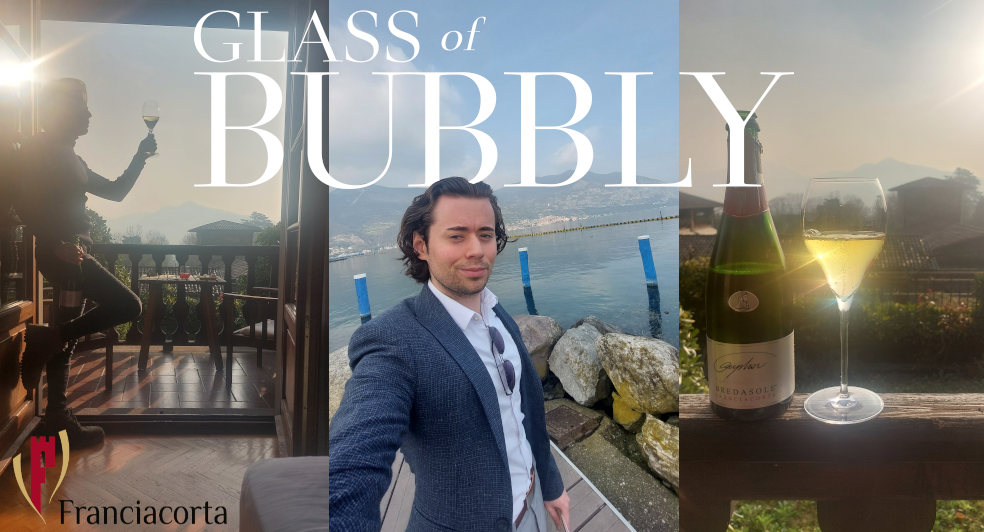
The whole world awaits patiently for a competitor to enter the fight against the behemoth that is Champagne, as English Bubbly builds its range, experience and knowledge to take on the fight in the next decade or two, it’s currently Franciacorta in Italy that strives to be the alternative for the Champagne lover.
The people of the small region of Franciacorta know their land well, opting to use very little, to no dosage, allowing the grapes and the terroir to do all the talking, apart from their sparkling wines, it’s Lake Iseo that takes your breath away, one of the most picturesque and memorable sights to see in Italy.
Although its vision is to position itself in the same league as Champagne, does this charming region of Italy have the potential to go toe to toe against the giant that is, Champagne?
I recently had the chance to visit and explore Franciacorta, discovering some of its wonderful producers, its terroir and the sparkling wines it has to offer for myself, below I’ll recount my experiences, share some of the wonders of the region and begin answering the question, where does Franciacorta stand in the bubbly world?
Franciacorta
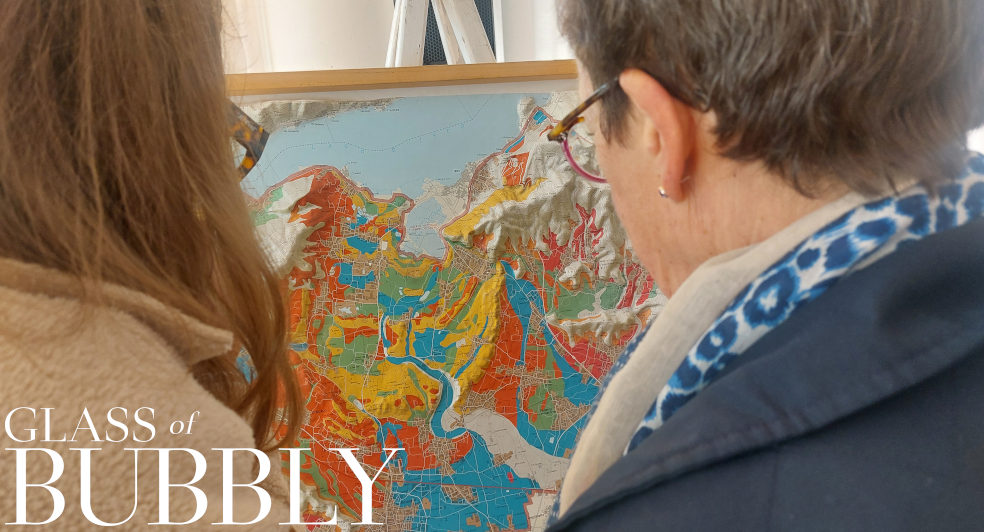
With a production between 17 to 20 million bottles, around 3,000 hectares and an export market of 10%, it has some way to go in filling the gaps that Champagne have presented. Franciacorta DOCG was introduced in 1995, with the Estates and Wineries of Franciacorta still being mostly owned by Italian Families, there hasn’t been much outside investment, so you’re very likely dealing with a member of the family that founded everything.
I visited 7 different wineries throughout different parts of the region, getting to know their wines and the land on which they all come from.
With each visit we started with their entry label, introducing us to their brand, and more often than not I was impressed as they captured the essence of Franciacorta. The oldest vintage we got to try was a 2008, which although it had about 16 years of ageing, it still felt far too young, with most of its life in front of it, I believe a tasting in at least 10 years time, would gift a more perfected performance.
If it ever came to picking Franciacorta out from a blind tasting flight of wines, it wouldn’t be too hard to choose correctly, Franciacorta has a style that runs throughout all the wineries we had the chance to visit, displaying a mix of prominent acidity, yellow citrus, minerals, wet stones and fresh yellow stone fruits – it’s the terroir at work here, and in Franciacorta, they like to let the terroir do most of the talking, so if you like the style of Franciacorta, this allows you to explore a vast majority of the wineries, discovering new labels that you’ll enjoy.
The region is primed with good terroir, they say its sparkling wines don’t require much in addition to any dosage to discover its fruity characteristics. Although Franciacorta doesn’t have the marketing capital that would be required to push the name so prominently as the likes of Champagne, it does have a fantastic Consortium that involves 98% of the wineries in Franciacorta, which helps push and showcase the quality of the region around the world.
An unnamed talented and passionate lady from our trip to Franciacorta mentioned something that stuck with me when she spoke about her time studying for a WSET exam, “We speak of Franciacorta for 5 minutes and we speak of Champagne for 5 hours” This goes just to show, the mountain that Franciacorta has to climb to achieve thier worldwide mission.
Day 1 – Discovering Franciacorta
Landing in Franciacorta on a mild sun filled mid-afternoon, we were greeted by the driver ready to take us to our hotel, with a bottle of Franciacorta nicely boxed in a branded bag with some great information accompanying it.
The hotel (Relais Franciacorta) was tucked nicely away with picturesque views of the surrounding mountains, the anticipation of venturing into the wine region was in full steam, our first winery visit on our trip, allowed us to discover Berlucchi Guido, taking a tour, tasting their wines and joining the family for an excellent light dinner.
Berlucchi Guido
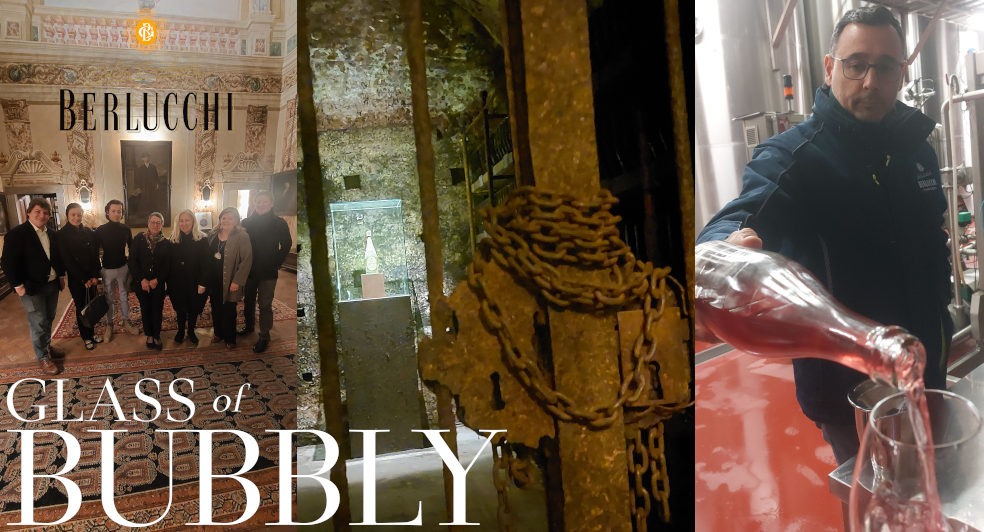
Berlucchi Guido produces 3.5 million bottles on 500 hectares a year, they own 140 hectares and the rest are rented, with 60% of the rented vineyards growing organic grapes. 15-20% of the grape juice gathered from any specific year is moved into their reserve tanks. Their Cuvée Imperial line contains 6 labels and is mainly produced for the Italian supermarket scene.
It was interesting to note that they now keep 1,500 bottles of every vintage so they can start building a mighty library of wines, starting their oenothèque range from the 2002 vintage.
While touring their winery we met their winemaker, who was excited to share with us some of their younger wines, still containing the yeast, and yet to hit the market. Here are my tasting notes on them.
Berlucchi Guido – TN: “Apple juice, freshly squeezed with notes of yeasty characters. Flavours are crisp, acidic, sour green apples, very life like, and unique. Still contained the yeast.”
Berlucchi Guido – Chardonnay TN: “More real ripe green apple juice, slightly different, with a bigger mix of faint other orchard fruits. Creamy sour citrus, green apples, almost apple sherbert flavour, with notes of honeydew melon and mouth watering with acidity. Still contained yeast.”
Berlucchi Guido – 100% Pinot Noir TN: “Creamy milky strawberry and red berries, strawberry yoghurt, light feta cheese, more strawberry. Ripe and slightly unripe strawberry, more bitter notes.”
Berlucchi Guido – Both the Chardonnay and Pinot Noir together in one glass: “Strawberry, apple juice and honeydew melon. Softer expression, nicer combination, smooth apple juices, juicy melons.”
Venturing up into their grand tasting room, we got to taste 8 of their Sparkling Wines, including their famous 61 labels and the oldest vintage of our trip, a 2008 vintage.
61 Satèn: “Very fresh in the palate, fizzy, millions of bubbles popping on the tongue, sweet citrus, delicate lemon sherbet, mango skin on the aroma.”
61 Extra Brut: “Not so vibrant as the first, still with very similar characters, but with a delicate brioche and bakery aroma. Candy, melon candy, tropical candy.”
61 Rosé: “Raspberries on the aroma. Delicious pink strawberries and raspberries on the palate with notes of creamy squirty cream and vanilla ice cream sensation, with pink Pomegranate.”
61 Nature Blanc de Blanc 2016: “Fruity notes, a touch of yeast, bruised green apples. Rich, golden fruits, very bold in the glass, a vibrant citrus/zesty lemon fizzy on the palate.”
61 Brut Nature 2016: “Shortcake, subtle brioche, freshly baked, biscuits.”
61 Nature Rosé 2016: “Strawberry shortcake, ripe freshly sliced strawberries on shortbread. Vibrant strawberries, raspberries, very well baked shortbread.”
Palazzo Laura 2011: “Golden aged finesse, subtle yellow stone fruits, with some ageing to them, mature lemon citrus, malolactic.”
Franciacorta Riserva Cuvee 2008: “A very subtle reminder of Ratafia, one of the light yellow stone fruit driven examples, golden syrupy, apricots both dried and fresh, wild yellow and white floral. Concentrated golden and yellow stone fruits, strong in character, acidic and lemon skins.”
When returning home to England, I was shortly after able to taste a bottle of Berlucchi 61 Brut 2017 Vintage, discovering: “A finer aged complexion, enhancing a richer baked bread, okay, pastry display, with glorious golden fruits and lemon zest, touch if minerals and chalk in length, you also get a sweet taste of lemon tart, the wine in the bottle has aged wonderfully, although I still taste how young it is, I believe Franciacorta has a great potential for further ageing.”
Day 2 – Exploring Franciacorta
Barone Pizzini
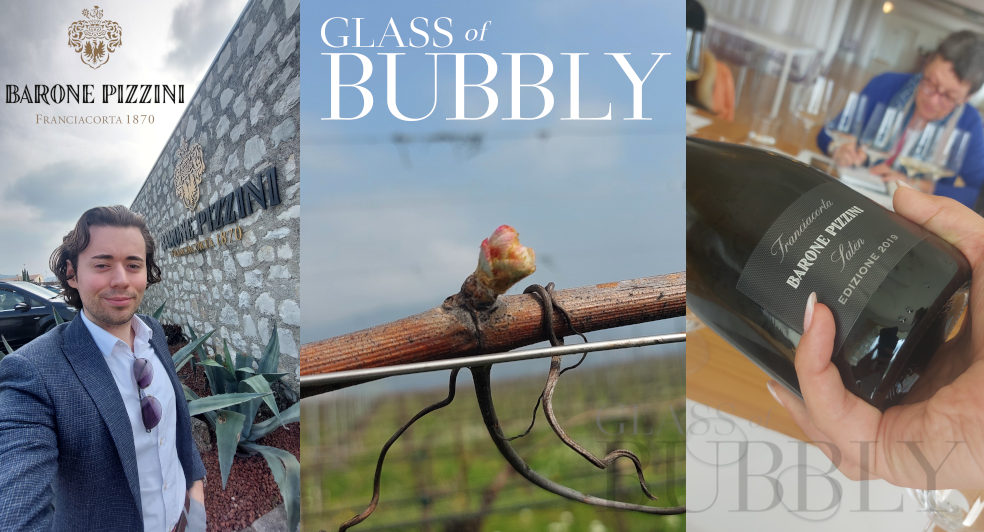
Beginning the second day together, after a relaxing breakfast with some staggering views of the mountains, we ventured to Barone Pizzini, with a production of 300,000 bottles, with 85% of its bottles sold and consumed within Italy.
We started by tasting their best seller and their biggest product, taking up 1/3rd of their production, with 100,000 bottles, and costing 25 euros, their Golf 1927 Franciacorta DOCG: “Very real sherbety citrus of lemon, and yellow and tropical fruits, subtle kind citrus, yellow and white floral notes and blossom.”
Animante Franciacorta DOCG: “Creamy buttery toast, smooth almost creamy, mature and elegant butter texture, notes of brioche and shortbread, mature green fruits, yellow stone fruits and lemon citrus.”
Rosé Franciacorta 2019 DOCG: “Zesty red berries, vibrant red citrus, ripe cherries and red currants.”
Lunch – Trattoria del Muliner
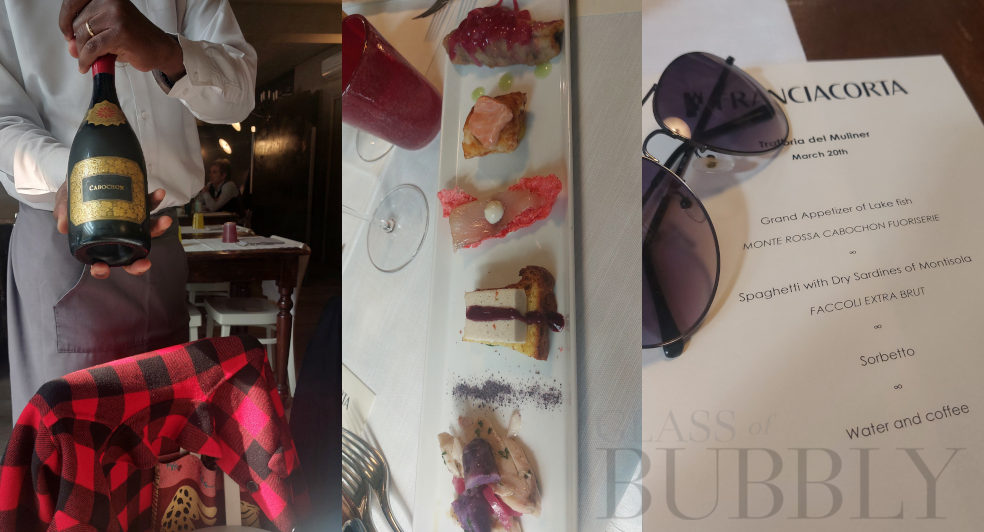
Next, we travelled to Trattoria del Muliner, a must visit little restaurant right next to the stunning Lake Iseo, where we got to taste the flavours of the lake, sampling the food that was freshly caught from the lake itself, after lunch we got a moment to see first hand Lake Iseo, it was impossible to capture the essence of view, it’s one of those places that you need to experience first hand to truly appreciate.
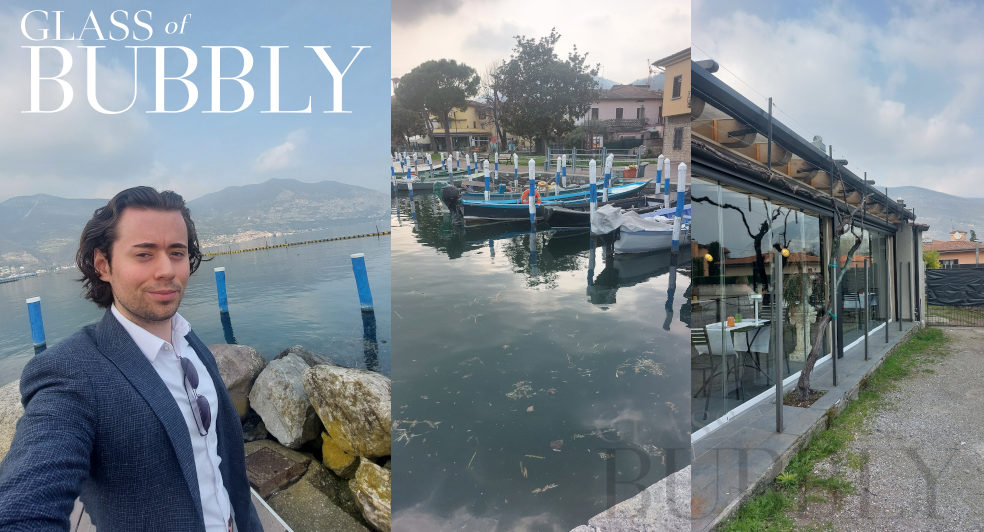
Marchese Antinori
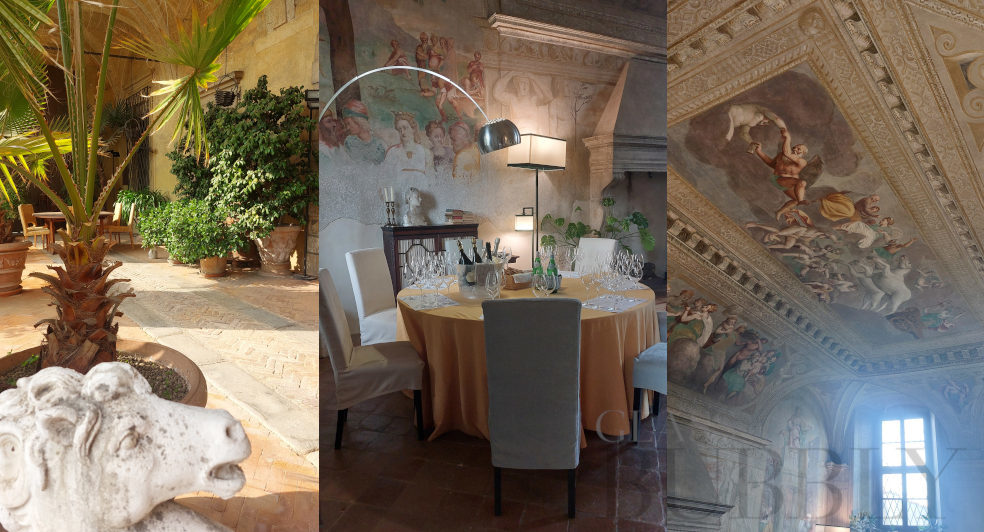
A wonderful front to the establishment, making you feel like you’re in a prime tropical location, enjoying the finer things in life, from the lemon trees and palm trees, this winery had wonderful vineyards, an exceptional display of their barrels, and a timeless tasting room, with paintings and architecture that could rival some of the greats.
Tasting first their Cuvée Royale which produces on average 180,000 bottles, costing 15 euros from the cellar door, I discovered: “Bold citrus, minerals, acidity. vibrant and ripe yellow stone fruits, plus more.”
Their Rosé impressed me the most with: “Blushing strawberries and red berries, pink strawberries and mossy notes, along with strawberry, blackberry juice, maraschino cherries, baked cherries and strawberry tarts.”
The rest of the range we tasted, including their Donna Cora Satèn 2019, Contessa Maggi 2016 and Conte Aumo 2018, although perfectly captivating the essence of Franciacorta, I felt they were a little young, with their best years ahead of them, some exceptional ageing potential.
Ricci Curbastro
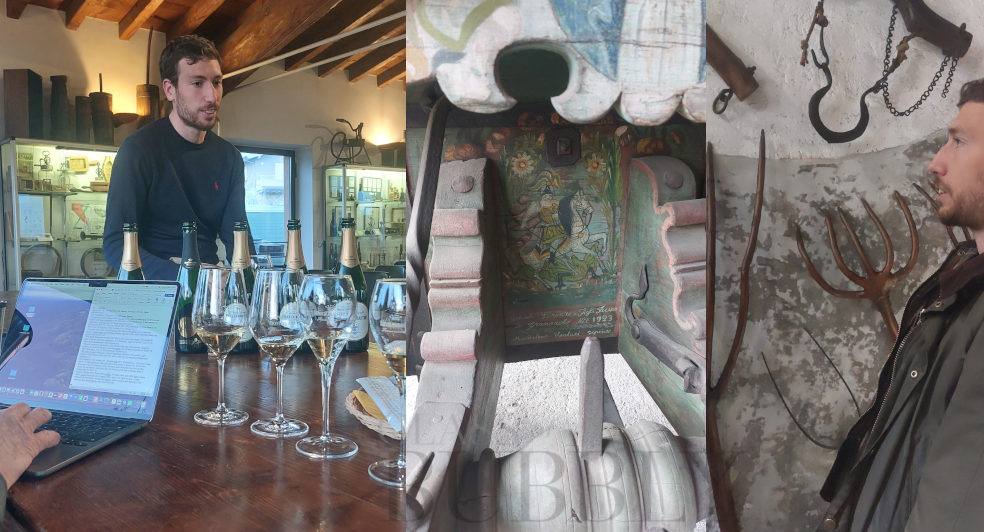
Taking a step back in time, allowed us to explore an incredible display of the history of wine, hosting a museum to all the old tools of the trade, departing onto us the knowledge and wisdom of the olden days, from old grape presses, tools of harvest and equipment that aided the horses, they showed us three buildings worth of history, allowing us to see how far the wine industry has advanced in harvesting and producing sparkling wine.
Ricci Curbastro exports 30% of its production to countries like the US, Mexico, Germany, Belgium, Japan and Australia, producing between 200,000 to 220,000 a year.
Day 3 – Understanding Franciacorta
Ca’del Bosco
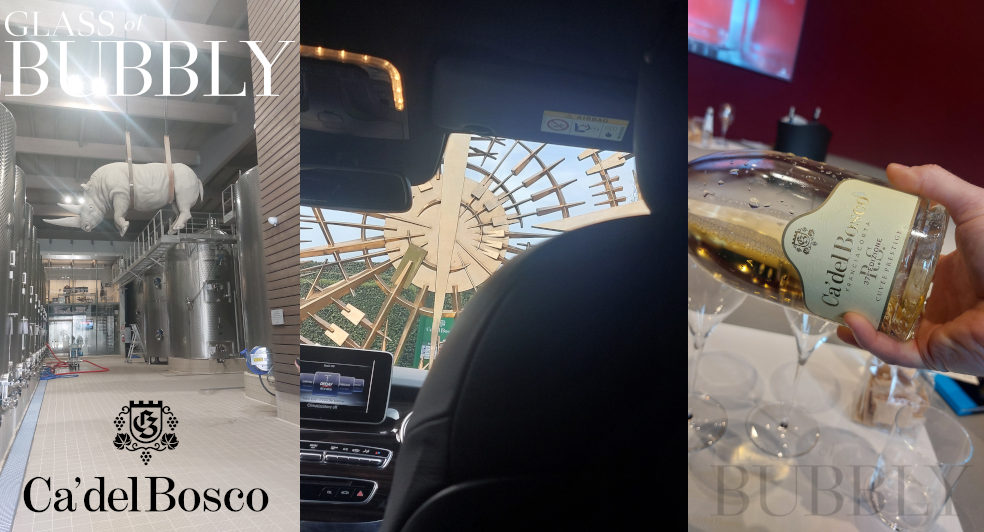
Ca’del Bosco first produced Franciacorta in 1976, they are one of the most well known and successful houses in the region, with the very recognizable and memorable ‘golden gates’ which greets every visitor. To add to this, they have a state of the art interactive map of the region, a magnificent photo ready pond, a helicopter pad and state of the art winery and tasting room.
Cuvee Prestige: “Buttery bread, light toast, acidic, buttery texture.”
Dosage Zero: “Light, clay, rocks, subtle saline, salty sea air, light floral and a touch of bread, delicate and easy to enjoy, with light acidity.”
Ferghettina

Welcome to Ferghettina, they first harvested in 1991 for their red and white wines, with Franciacorta first being harvested in 1992, Roberto Gatti is the father and founder of Ferghettina. He started off by renting a small garage/old building and not having any money to buy land or equipment for the production, he had to borrow money from the bank to start the venture.
They now own 30 vineyards, and rent a further 190 vineyards, for 20 to 25 years at a time. All of their vineyards are organic.
Ferghettina has around 60 workers, many of which are manual hands, with at least 70% working in the vineyards.
They have a production of 500,000, producing 7 different labels of Franciacorta.
Now, this winery has an element to it that helps it stand out as something truly different, they have some truly beautiful vineyards, a wonderful tasting room, a cellar and an Oenothèque that could keep you entertained for months, but it is their square-shaped bottles that set them apart.
We’re used to seeing wineries trying something new, with unique bottle designs, embossed bottles, creative labels and so on. Still, this design was chosen for what they truly believed in, and they were smart enough to obtain the patent for the bottle design, but will the other wineries of Franciacorta decide to make the switch?
It was in 2011, on the 2007 harvest, that they started to use the patented square bottle design, believing it overall enhances the quality of wine within the bottle, their consumers seem to love it, but other wineries seem unconvinced.
They put together a focus group of 21 people to taste the difference between a standard bottle and a square bottle, the results found that 19 out of 21 people who tested the same sparkling wine from both bottles, said that sample A, the one in the square bottle, was more complex.
An interesting result, unfortunately, I can’t comment on this study as we were not given the chance to compare, it would have certainly been interesting to have tasted the difference, but Ferghettina have moved full steam ahead with their square bottle design, so for better or worse, this is the future of Ferghettina, and it is certainly a great marketing tool for them to take advantage of.
Satèn 2020: “Fruity soft and delicate zestyness, buttery fluffy pancakes, minerals.”
Milledi 2020: “Creamy mousse character, pastries with lemon curd and lemon skin.”
Rosé: “Ripe raspberries, pink rose petals, strawberry, strawberry leaves, foliage, natural herbs, moss in the palate with red apples, red fruits, and red berries.”
Extra Brut Riserva 2015 – 6-7 thousand bottles a year: “Cherry sweets, chewy sweets, sweet candy and pastry tart, gooseberries.”
1701

When we visited 1701, they had just completed their 4 day bottling process, and although they were exhausted by their endeavour, they were still full of energy and passion when it came to showcasing their vineyards and range of Franciacorta to us.
Using bees as markers for their vineyard, they explained how it’s an excellent sustainable and environmentally friendly tactic to ensure that their vineyards are kept at optimal condition. Bees are one of the first animals in nature to react to unsafe and destructive conditions in the vineyard, so if the bees are healthy and thriving, so will the vineyards and wildlife surrounding them.
They have a production of around 120,000 bottles, with their first vintage taking place in 2011.
During the tasting, it was mentioned that Satèn has to be a Brut, it cannot be a Zero Dosage, but, the conditions of Brut is between 0 and 12 grams of sugar, “so we are moving within the law without adding any sugar”, they are using the loophole available to them as they don’t want to add sugar. The Satèn label was apparent from every winery we visited, so is important for the winery to have it available to consumers to discover.
Brut Nature: “Tangy lemons, citrus, acidic, minerals, wet stones”
Rosé 2019: “Red berries, chewy cherries, plum cherries, ripe and delicious, fresh and moreish, a touch of bakery, pastry, raspberry pastry tart. Mediterranean herbs, wild herbs.”
Dosage Zero 2016: “Fizzy citrus, lemons, lemon blossom, fresh, clean cut, acidic with citrus, zesty lemons and limes, pastries and lemon tart.”
Satèn 2020: “To the point with the acidity yet still very fresh, delicious and moreish, still plenty of room to open up, but in a great tasting place right now.”
LSD 2018: “Acidic, citrus, minerals, wet stones, and chalky notes.”
LSA 2020: “Minerals, chalk, wet stones, softer acidity, a touch of icing sugar on freshly baked pastries on the aroma. A sweet icing sugar taste with citrus and minerals.”
The End Of Our Journey In Franciacorta
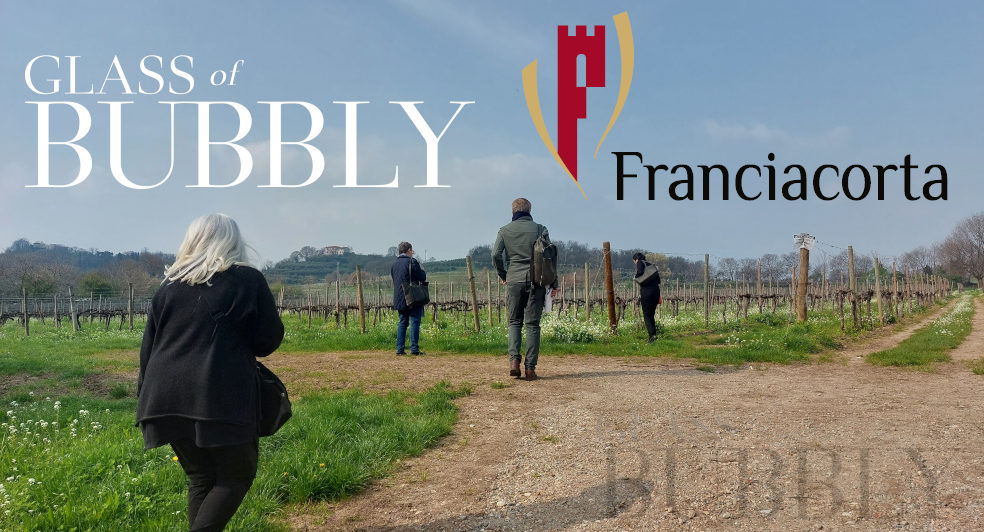
What a remarkable trip this has been, enlightening, entertaining and unforgettable, my time in Franciacorta, for now, has come to an end, and my mind has been expanded on the topic of Franciacorta, discovering a whole host of different colours, grapes, flavour profiles, wineries and people, I think it’s time to pour myself another glass of Franciacorta to commemorate the end of this trip, thank you to Consorzio Franciacorta, all the winemakers, producers, family members, crew, workers and organisers for making everything possible.
![]()
Oliver Walkey
Champagne and Sparkling Wine Writer, Focused on Bringing the Exciting and Fascinating World of Bubbly to You.
